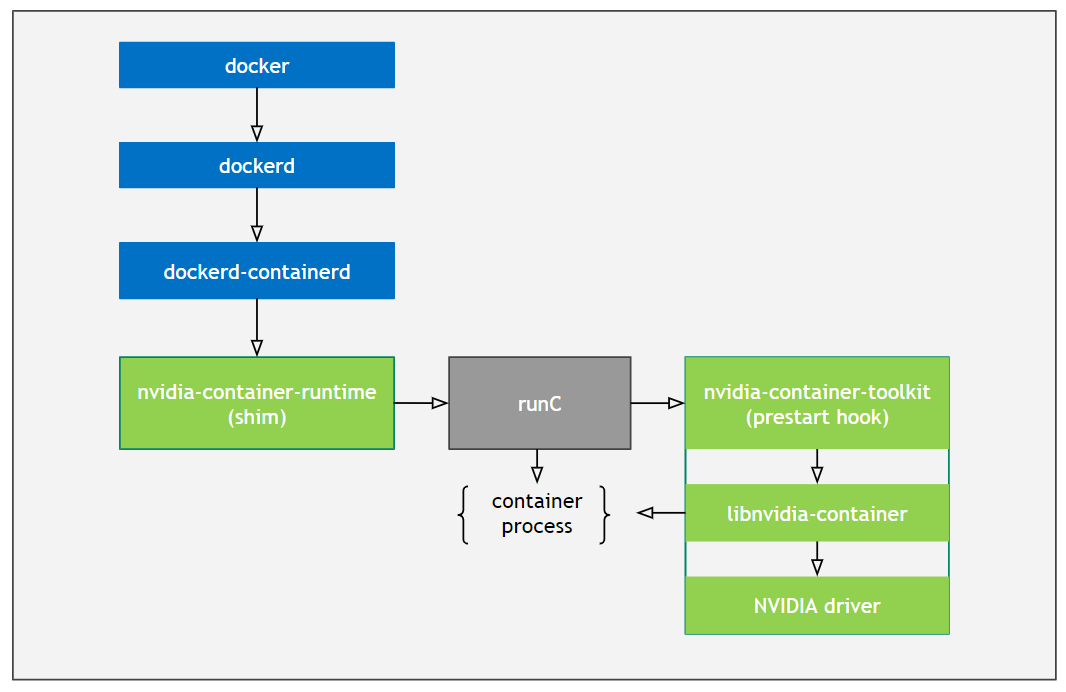Architecture Overview
The NVIDIA Container Toolkit is architected so that it can be targeted to support any container runtime in the ecosystem. For Docker, the NVIDIA Container Toolkit is comprised of the following components (from top to bottom in the hierarchy):
nvidia-docker2nvidia-container-runtimenvidia-container-toolkitlibnvidia-container
The following diagram represents the flow through the various components:

The packaging of the NVIDIA Container Toolkit is also reflective of these dependencies. If you start with the top-level
nvidia-docker2 package for Docker, the package dependencies can be seen below:
├─ nvidia-docker2
│ ├─ docker-ce (>= 18.06.0~ce~3-0~ubuntu)
│ ├─ docker-ee (>= 18.06.0~ce~3-0~ubuntu)
│ ├─ docker.io (>= 18.06.0)
│ └─ nvidia-container-runtime (>= 3.3.0)
├─ nvidia-container-runtime
│ └─ nvidia-container-toolkit (<< 2.0.0)
├─ nvidia-container-toolkit
│ └─ libnvidia-container-tools (<< 2.0.0)
├─ libnvidia-container-tools
│ └─ libnvidia-container1 (>= 1.2.0~rc.3)
└─ libnvidia-container1
Let’s take a brief look at each of the components in the software hierarchy (and corresponding packages).
Components and Packages
libnvidia-container
This component provides a library and a simple CLI utility to automatically configure GNU/Linux containers leveraging NVIDIA GPUs. The implementation relies on kernel primitives and is designed to be agnostic of the container runtime.
libnvidia-container provides a well-defined API and a wrapper CLI (called nvidia-container-cli) that different runtimes can invoke to
inject NVIDIA GPU support into their containers.
nvidia-container-toolkit
This component includes a script that implements the interface required by a runC prestart hook. This script is invoked by runC
after a container has been created, but before it has been started, and is given access to the config.json associated with the container
(e.g. this config.json ). It then takes
information contained in the config.json and uses it to invoke the libnvidia-container CLI with an appropriate set of flags. One of the
most important flags being which specific GPU devices should be injected into the container.
Note that the previous name of this component was nvidia-container-runtime-hook. nvidia-container-runtime-hook is now simply a symlink to
nvidia-container-toolkit on the system.
nvidia-container-runtime
This component used to be a complete fork of runC with NVIDIA specific code injected into it. Since 2019, it is a thin wrapper around the native
runC installed on the host system. nvidia-container-runtime takes a runC spec as input, injects the nvidia-container-toolkit script as
a prestart hook into it, and then calls out to the native runC, passing it the modified runC spec with that hook set.
It’s important to note that this component is not necessarily specific to docker (but it is specific to runC).
When the package is installed, the Docker daemon.json is updated to point to the binary as can be seen below:
/etc/docker/daemon.json
{
"default-runtime": "nvidia",
"runtimes": {
"nvidia": {
"path": "/usr/bin/nvidia-container-runtime",
"runtimeArgs": []
}
}
nvidia-docker2
This package is the only docker-specific package of the hierarchy. It takes the script associated with the nvidia-container-runtime and installs it
into docker’s /etc/docker/daemon.json file. This then allows you to run (for example) docker run --runtime=nvidia ... to automatically add GPU support to your containers.
It also installs a wrapper script around the native docker CLI called nvidia-docker which lets you invoke docker without needing to specify --runtime=nvidia every single time.
It also lets you set an environment variable on the host (NV_GPU) to specify which GPUs should be injected into a container.
Which package should I use then?
Given this hierarchy of components it’s easy to see that if you only install nvidia-container-toolkit, then you will not get
nvidia-container-runtime installed as part of it, and thus --runtime=nvidia will not be available to you. With Docker 19.03+, this is fine because Docker directly
invokes nvidia-container-toolkit when you pass it the --gpus option instead of relying on the nvidia-container-runtime as a proxy.
However, if you want to use Kubernetes with Docker 19.03+, you actually need to continue using nvidia-docker2 because Kubernetes doesn’t support passing GPU information
down to docker through the --gpus flag yet. It still relies on nvidia-container-runtime to pass GPU information down the runtime stack via a set of environment variables.
The same container runtime stack is used regardless of whether nvidia-docker2 or nvidia-container-toolkit is used. Using nvidia-docker2 will install a thin runtime
that can proxy GPU information down to nvidia-container-toolkit via environment variables instead of relying on the --gpus flag to have Docker do it directly.
For purposes of simplicity (and backwards compatibility), it is recommended to continue using nvidia-docker2 as the top-level install package.
See the Installation Guide for more information on installing nvidia-docker2 on various Linux distributions.
Package Repository
The packages for the various components listed above are available in the gh-pages branch of the GitHub repos of these projects. This is particularly
useful for air-gapped deployments that may want to get access to the actual packages (.deb and .rpm) to support offline installs.
For the different components:
nvidia-docker2https://github.com/NVIDIA/nvidia-docker/tree/gh-pages/
nvidia-container-toolkithttps://github.com/NVIDIA/nvidia-container-runtime/tree/gh-pages/
libnvidia-containerhttps://github.com/NVIDIA/libnvidia-container/tree/gh-pages/
Releases of the software are also hosted on experimental branch of the repository and are graduated to stable after test/validation. To get access to the latest
experimental features of the NVIDIA Container Toolkit, you may need to add the experimental branch to the apt or yum repository listing. The installation instructions
include information on how to add these repository listings for the package manager.